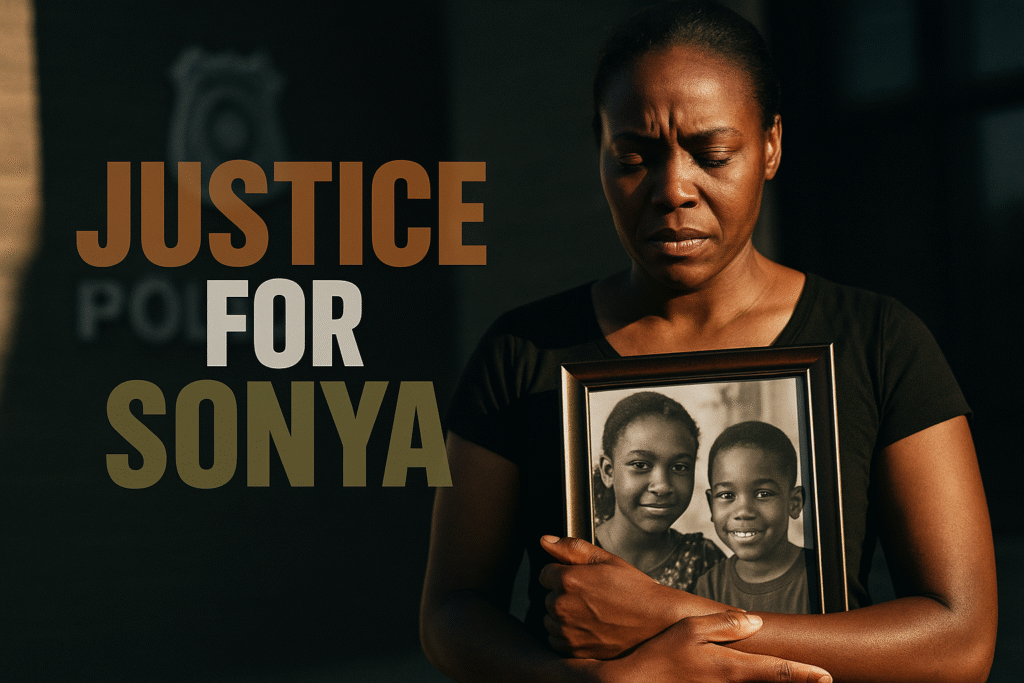

Sonya Massey Bill: A New Era for Police Hiring
By Darius Spearman (africanelements)
Support African Elements at patreon.com/africanelements and hear recent news in a single playlist. Additionally, you can gain early access to ad-free video content.
The Tragic Death of Sonya Massey
On July 6, 2024, Sonya Massey, a 36-year-old Black mother of two, was fatally shot by Sangamon County Sheriff's Deputy Sean Grayson, who is white (ipmnewsroom.org). This tragic event unfolded after Massey called 911 to report a suspected prowler outside her Springfield, Illinois, home (ipmnewsroom.org). Body-camera footage from the incident shows Grayson entering her home and instructing her to drop a pot of boiling water (ipmnewsroom.org). He then fired three shots at Massey (ipmnewsroom.org).
Grayson, a 30-year-old Sangamon County Sheriff's deputy, now faces serious charges, including first-degree murder, aggravated battery, and official misconduct, to which he has pleaded not guilty (usnews.com). He later claimed he felt threatened by Massey, interpreting her spiritual rebuke “in the name of Jesus” as an indication that she intended to kill him (usnews.com). Following the incident, Grayson was fired from the sheriff's office and is currently awaiting trial (cbsnews.com).
A Troubling Employment History
Sean Grayson's employment history reveals a pattern that raised significant concerns even before his hiring by the Sangamon County Sheriff's Office (ipmnewsroom.org). His relatively brief career in law enforcement saw him move between six different Central Illinois police departments in just four years (ipmnewsroom.org). This frequent movement between agencies is often a red flag in law enforcement hiring.
Furthermore, Grayson had been discharged from the U.S. Army due to serious misconduct and had two convictions for driving under the influence (DUI) from 2015 and 2016 (capitalbnews.org). Past employers had also questioned his integrity (ipmnewsroom.org). Sangamon County Sheriff Jack Campbell even admitted that Grayson had insufficient training when he was hired (ipmnewsroom.org). Massey's family has strongly argued that these past issues should have prevented him from being assigned to a law enforcement role, and they have called for Sheriff Jack Campbell's resignation (usnews.com).
The Sonya Massey Bill: A Legislative Response
In direct response to Sonya Massey's death, Illinois Governor J.B. Pritzker signed Senate Bill 1953, now known as the Sonya Massey Bill, into law on August 12 (newsone.com). This landmark legislation aims to significantly increase transparency and accountability in law enforcement hiring practices across the state (newsone.com). The new law mandates that all Illinois law enforcement agencies must investigate and disclose an officer’s full employment history, including disciplinary records and any prior misconduct, when that officer applies for a new position (newsone.com). It also requires thorough background investigations before any officer can be hired (newsone.com).
The bill garnered overwhelming bipartisan support, passing the Illinois Senate unanimously and the House with a vote of 101 to 12 (newsone.com). Key sponsors of the bill included State Senator Doris Turner (D-Springfield) and State Representative Kam Buckner (D-Chicago) (newsone.com). Sonya Massey’s father, James Wilburn, expressed his hope that this new law will improve the quality of law enforcement officers and help restore trust between police and communities, especially communities of color (newsone.com).
Strengthening Hiring Standards
The Sonya Massey Bill, Senate Bill 1953, seeks to implement substantive changes to how law enforcement applicants are reviewed before they are hired (capitalbnews.org). The bill was initially introduced on February 7 by Democratic Illinois State Representative Justin Slaughter (capitalbnews.org). Supporters of the legislation believe that if stricter hiring standards had been in place, it is highly probable that Grayson would not have been employed in law enforcement, and Sonya Massey might still be alive today (newsone.com).
This legislation was developed with valuable input from various organizations, including the Illinois Association of Chiefs of Police and the Illinois Sheriffs’ Association (newsone.com). It also received strong backing from the ACLU, the Illinois Attorney General’s Office, and numerous other law enforcement groups (newsone.com). The broad support for this bill underscores a collective recognition of the need for more rigorous and transparent hiring processes within law enforcement.
The Wrongful Death Settlement
In February, Sonya Massey’s family reached a significant $10 million settlement with officials in Sangamon County for her wrongful death (capitalbnews.org). This settlement provides a measure of recompense to the family, but it also represents a step towards greater accountability and policy changes within the county's law enforcement (25newsnow.com). Sangamon County Board Chair Andy Van Meter stated that the settlement is part of the county's ongoing efforts to address Sonya Massey's tragic death (25newsnow.com).
The county is committed to improving its policies and practices through a memorandum of agreement with the U.S. Department of Justice, aiming to prevent similar tragedies in the future (25newsnow.com). Van Meter also emphasized the county's commitment to working with the community to strengthen policies to ensure such incidents never happen again (25newsnow.com). While the settlement brings some accountability and closure, the family's attorneys, Benjamin Crump and Antonio Romanucci, acknowledged that “nothing can remove the persistent pain, frustration and grief caused by her senseless death” (capitolnewsillinois.com).
Grayson's Trial and Its Implications
The trial of Sean Grayson, the sheriff's deputy accused in Sonya Massey's shooting death, has been moved (capitolnewsillinois.com). While the specific reasons for this change of venue are not detailed, such moves are typically granted to ensure a fair trial, especially when there is concern that extensive local media coverage or public sentiment might bias a jury. A Sangamon County grand jury has indicted Grayson on five counts, including three counts of first-degree murder (sj-r.com).
The denial of courtroom cameras, while not explicitly addressed in the provided information, generally relates to concerns about witness intimidation, maintaining decorum, or protecting the privacy of participants. This can, however, impact public transparency. The timeline for the trial is not explicitly stated, but the proceedings are ongoing. The outcome of this trial will undoubtedly have significant implications for law enforcement accountability and community trust.
Mental Health and Law Enforcement Response
At the time of her death, Sonya Massey was experiencing a mental health crisis, according to a family spokesperson (capitolnewsillinois.com). In the days leading up to the incident, Massey's mother had called the police, informing them that Massey was having a mental breakdown and acting like a “paranoid schizophrenic” (capitolnewsillinois.com). However, this crucial information was not relayed to Deputy Grayson by dispatchers when he was sent to her home (capitolnewsillinois.com).
This highlights a significant gap in how mental health information was communicated and, potentially, how law enforcement officers are trained to handle individuals in such crises. The specific nature of Massey's condition is not further elaborated, nor are the details of law enforcement training in these scenarios. The incident underscores the critical need for improved communication protocols and specialized training for officers responding to mental health-related calls.
Key Elements of the Sonya Massey Bill
Full Employment History Disclosure: Law enforcement agencies must investigate and disclose an officer’s complete employment history, including disciplinary records and prior misconduct.
Thorough Background Investigations: Mandates comprehensive background checks before an officer can be hired.
Increased Transparency: Aims to prevent officers with problematic histories from moving between agencies without proper scrutiny.
Grayson's Employment History Under Scrutiny
Deputy Steven Grayson's employment record came under intense scrutiny following the shooting of Sonya Massey (capitolnewsillinois.com). It was revealed that he had worked for six different departments in just four years and had two convictions for driving under the influence (capitolnewsillinois.com). The specific nature of other misconduct beyond the DUIs is not detailed in the provided information, nor are the exact reasons for his frequent job changes. The question of how these issues were overlooked during his hiring by the Sangamon County Sheriff's Office has been a central point of contention, leading to broader questions about hiring practices within the county (capitolnewsillinois.com).
Massey’s death has raised significant questions about the hiring practices at Sangamon County, eventually leading to a U.S. Justice Department investigation (capitolnewsillinois.com). This investigation suggests a systemic issue that extends beyond just one individual officer. The focus is now on how such a problematic employment history could have been overlooked, allowing an officer with a history of misconduct to continue serving in law enforcement.
Justice Department Investigation and Sheriff's Retirement
The tragic death of Sonya Massey prompted a U.S. Justice Department investigation into the hiring practices at Sangamon County (capitolnewsillinois.com). While the existence of this investigation is confirmed, the provided information does not detail its specific findings. Similarly, while Sheriff Jack Campbell's early retirement is mentioned, the reasons behind his retirement are not elaborated upon in the given context. However, the county has stated that it is working to improve its policies and practices through a memorandum of agreement with the U.S. Department of Justice (25newsnow.com).
This suggests that the investigation is indeed influencing changes within the sheriff's office. The commitment to a memorandum of agreement with the Justice Department indicates a recognition of past deficiencies and a proactive approach to addressing them. The community will be watching closely to see how these changes are implemented and whether they lead to a more accountable and transparent law enforcement agency.
The “Pot of Boiling Water” Incident
During the fatal encounter, Sonya Massey reportedly threatened Deputy Grayson with a pot of boiling water (capitolnewsillinois.com). However, news reports indicate that she was “not near the deputy” when this occurred (capitolnewsillinois.com). This detail suggests a significant discrepancy between the perceived threat and Massey's actual proximity to the officer. The information does not explicitly clarify whether Grayson perceived this as an immediate threat justifying the use of lethal force, nor does it detail how this specific action influenced his decision to shoot an unarmed Massey in her kitchen (capitolnewsillinois.com).
The fact that Massey was unarmed and not in close proximity to the deputy raises serious questions about the proportionality of the force used. This aspect of the incident is crucial for understanding the dynamics of the encounter and the decisions made by Deputy Grayson. It further emphasizes the need for clear guidelines and training on de-escalation tactics, especially when individuals are experiencing mental health crises.
Timeline of Key Events
Sonya Massey fatally shot by Deputy Sean Grayson after calling 911.
Grayson charged with first-degree murder, aggravated battery, and official misconduct.
Governor Pritzker signs Senate Bill 1953 (Sonya Massey Bill) into law.
Massey's family reaches a $10 million wrongful death settlement with Sangamon County.
Racial Dynamics in the Case
The provided information notes that Sonya Massey was Black and Deputy Steven Grayson is white (capitolnewsillinois.com). While this racial dynamic is stated, the data does not explicitly explore whether racial bias was investigated as a factor in the shooting incident or whether it was considered in the development of the subsequent legislation, such as the Sonya Massey Bill. The primary focus of the available information centers on mental health crisis response, law enforcement training, and hiring practices.
However, in the African American community, the racial disparity in police shootings is a deeply felt concern. The fact that an unarmed Black woman was shot by a white officer, especially during a mental health crisis, resonates with a long history of similar incidents. While not explicitly stated as a factor in the investigation or legislation, the racial context of this case is undeniably significant for many, particularly those advocating for police reform and racial justice.
ABOUT THE AUTHOR
Darius Spearman has been a professor of Black Studies at San Diego City College since 2007. He is the author of several books, including Between The Color Lines: A History of African Americans on the California Frontier Through 1890. You can visit Darius online at africanelements.org.
